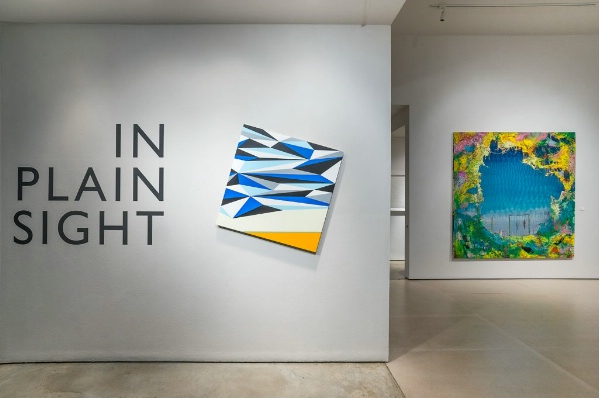
In Plain Sight at McClain Gallery
This is officially the season of painters’ painters. Three major exhibitions curated by Houston-based painters have opened in the last five months– “In Plain Sight” curated by Aaron Parazette at McClain Gallery, “Common Objects” curated by Shane Tolbert at David Shelton Gallery, and now “Artist’s Picks” curated by Howard Sherman at HAA. Abstract painting has long been an important part of the Houston art scene, but these three exhibitions give us a sense of a tight-knit community of artists, who want to play a significant role in presenting their own art.
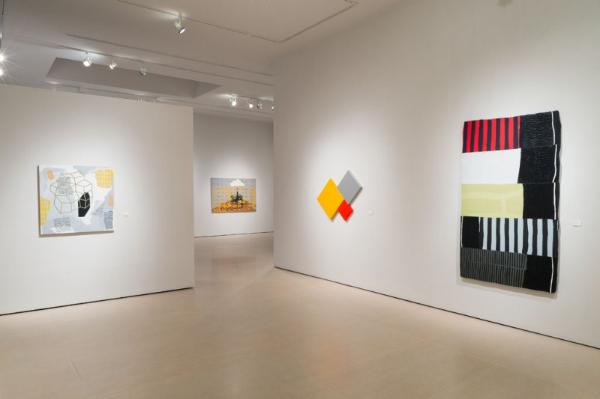
Pat Colville, Robert Ruello, Myke Venable, and Jeremy DePrez at McClain Gallery
“In Plain Sight” showed that Houston painters share an interest in formal questions, but not in developing a unified aesthetic. All painters in the exhibition were looking for that perfect balance of harmony and dynamism in technique, color, and composition, but each artist had their own idiosyncratic solution. The placement of abstract paintings in the most prominent sight lines in the galleries reinforced an implicit assertion that painting should primarily be concerned with form and technique over concept and content– an idea that I will return to later.
The group of seven painters at HAA are also interested in formal concerns, but more focused on ways that painting can grow out of a mixture of chance and control. Geoff Hippenstiel is the most spontaneous of the group with a field of silver and pinks built from layers of gestural swipes and mounds of daubs. The composition seems to be the result of intuitive movements and decisions.
Michael Guidry’s mural, adjacent to Hippenstiel, could not be more different than its neighbor. Hard edged zones of color are tightly controlled and precisely composed. Chance in Guidry’s practice comes only in the process of developing the composition from a photograph through various manipulations to a final form, determined by digital distortions, that is recognizable only to the artist and completely open to the viewer’s interpretation.
Sherman’s work ranges from explosions of gestural, seemingly automatic mark making to black outlines and hard edge slivers. His canvas struggles to contain the competing energies of various overlapping microcosms of cascading drips, contrasting neons, extreme tonal contrasts, and outlined “characters” that look like hands, faces, or bodies of some sort.
Robert Ruello speaks the language of painting with ease in saturated colors and compositions that unfold in layers. Every artwork is its own distinct world of impressively varied techniques used to reproduce images that Ruello has created by distorting and overlapping various digital images. Instinct and intent combine in a fluent expression.
Tutor Mitroi’s shaped panels are detailed topographies of lines and edges that resemble roads, rivers, and national borders, although any specific reference is unclear. One has the sense when looking at the work that one is conducting research and surveillance of a foreign landscape, a feeling of power and danger that is reinforced by painting’s searing crimson.
Marcelyn McNeil’s contribution to the exhibition at HAA is far more linear than the work she has shown over the last three years. The bright purple and red lines bring attention to the edges of McNeil’s forms, which are exciting places where one can see her multilayered process. The lines also define thick and smooth sections of white and cream that are beautiful and might otherwise pass unnoticed. One gets the sense that she trusts her process of mark making and has only come back later to outline and enhance what she has built up.
Shane Tolbert’s large, sectioned canvas is an intriguing outlier in the group as it is not painting, per se. What looks like a photographic process is achieved through a reductive process of removing dye from black cloth. The color and whiteness of the circles are determined by how long Tolbert allows a bleach-like substance to soak into the cloth. The resulting forms look like a series of astronomical photographs of sun storms, eclipses, rings, or nebula.

Lane Hagood at David Shelton
Tolbert has curated an concurrent exhibition at David Shelton of three gallery artists that also differs significantly from the others. By limiting the number of artists, Tolbert’s is the only one of the three exhibitions of painter’s painters to allow all included artists to show multiple or large scale works. We get a sense of the painters developing bodies of work and therefore more of the ideas that motivate them– such as studies of hands and feet in the case of Lane Hagood.
Or Nathan Hayden’s small paintings and notes that are small anecdotes on their own but add up to a swirling wall installation where viewers can move from painting to thoughts, drawing their own connections.
The variety of Ted Gahl’s compositions is also impressive, and makes his corner of the exhibition like a group show onto itself. It demolishes the idea of a singular style or vision and pulls the pieces into something really exciting. Why can’t an artwork have the liberty to be something unique, free from the tyranny of “the artist” as a cohesive, marketable being?
Which brings me back to the question of whether concept or content have a place in painting in Houston. There is an exhibition of Houston artists up at the Station Museum that includes types of painting that we are not seeing in these other exhibitions. Such as painting typically done on buildings and city streets, for example Daniel Anguilu’s murals.
Or artwork that tells a story, such as Lynn Randolph’s figurative paintings about the passage from life to death. In the three exhibitions discussed above, painters are showing a type of painting that largely excludes narrative, cultural reference, or any sort of controversial concept. Not that artwork needs to include these things, but when painters curate their own exhibitions, why do they lean toward questions of formal choices or artistic practice over social engagement? And what does that say about how many painters see themselves and their community of painters? And how does the self-presentation of painters often differ from the presentation of painting in institutions with an educational mission? These are complex questions that will I will continue to ask as I go to painting exhibitions in Houston. Another opens at Wade Wilson Gallery this weekend.
Common Objects at David Shelton Gallery is on view until February 16.
HX8 at the Station Museum will be on view until February 17.
Howard sherman: Artist’s Picks will be on view at HAA’s Alliance Gallery until March 26.



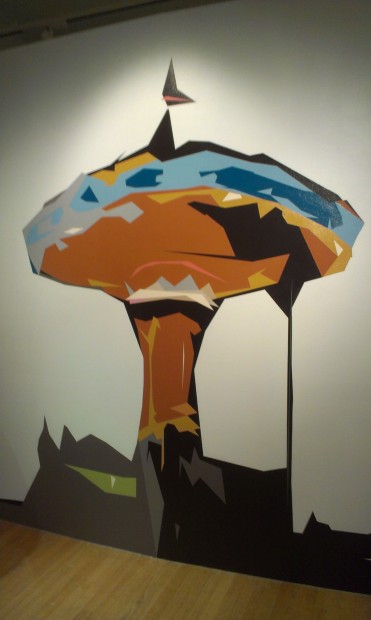
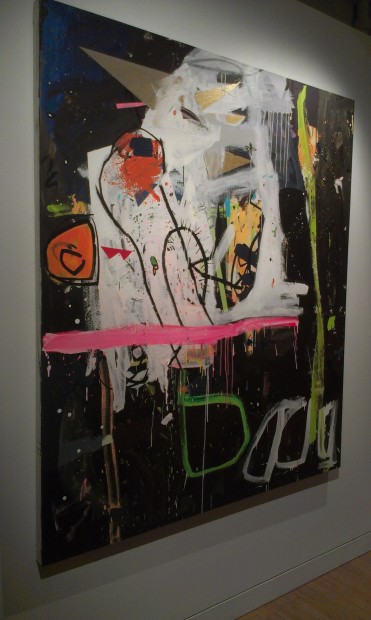
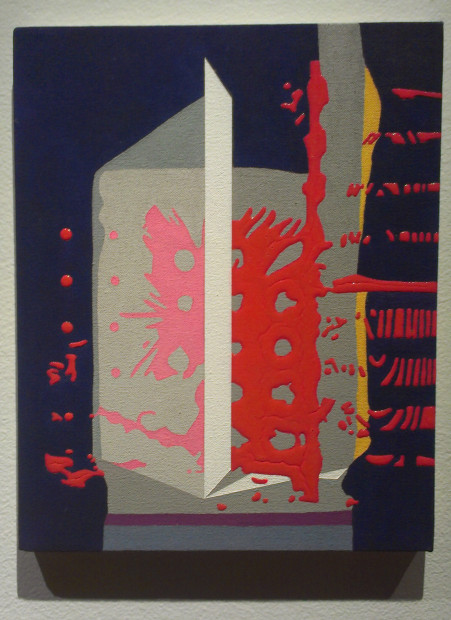
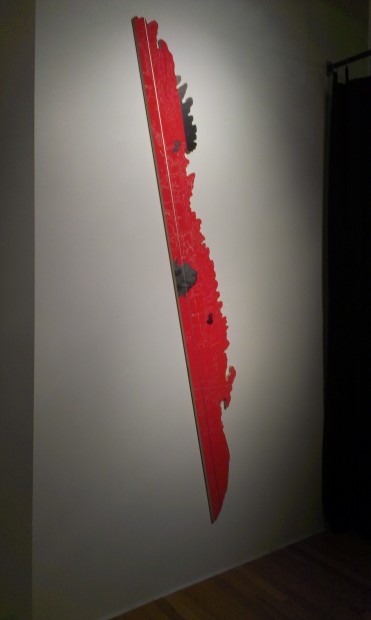
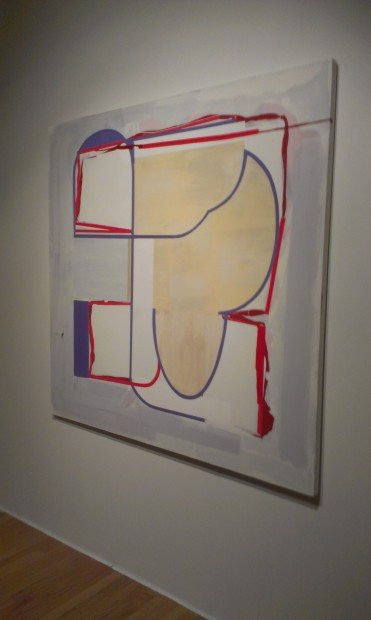
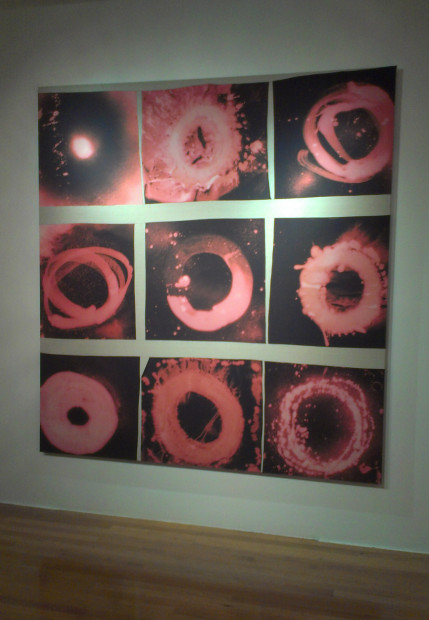

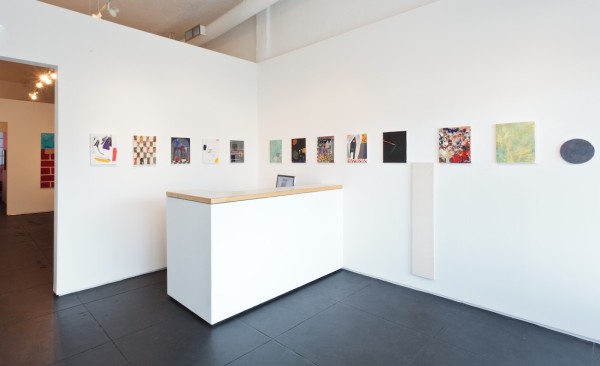
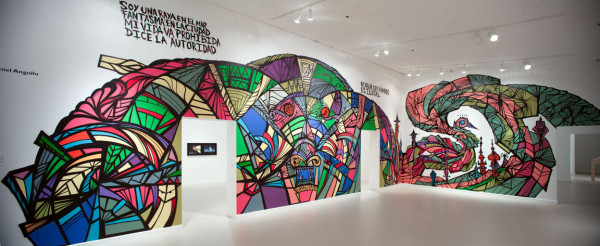
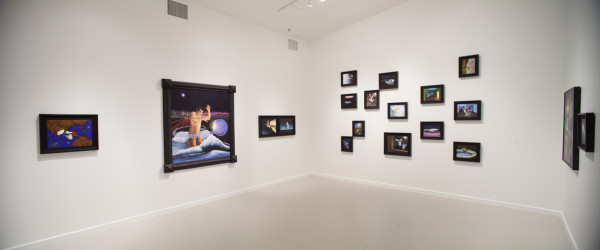

17 comments
The picture plane is inescapable even for the most narrative of painting. I think that those who believe that abstraction deals with formal questions more rigorously are oddly enough reverting to literal thinking. Absence of evidence is not evidence of absence. And I have yet to meet the painter who thinks this way. Or, maybe I just avoid obnoxious company. I certainly doubt that Mr. Hippenstiel instructs his figure drawing students that placement and mark has no or even secondary import. Maybe this is why the phrase ‘painter’s painter’ so often sees use. Veils are only that, and their opacity is hardly the measure of what lies beneath.
Anyhow, this is a great place to push paint around (in whatever manner) and I enjoyed the read tremendously.
Thank you for these great points, especially “absence of evidence is not evidence of absence.” I totally agree. I guess what I am saying is that if there is no unifying theme in the exhibition beyond a common medium (to be fair, there is in Tolbert’s show), and if there is very little information presented on the artists’ concepts, then a viewer is left to draw strictly formal comparisons as they walk through the gallery. Are materiality and composition really what painting is about here? I believe that painting in Houston is more forward looking, I just do not think the way painters are curating painting is emphasizing new horizons.
What I think you mean by forward looking or socially engaging is something I think of as also inexorable from the materiality of painting at its best and often most sincerely and effectively conveyed at the lower dB. levels. Formal is a tricky word when applied to art. I think of it as universal rather than exclusive and academic. I would say those painters and curators are doing it, even if ‘it,’ is short of saving the universe. Or proclaiming to with a bullhorn pointed at a room of claquers. It’s going to happen and happen best, I think, without ham-fisted engineering. Emotion has its place along with ideas. And as far as outreach, I’d say the former outstrips the latter. But that’s not to say I don’t want to see your vision of the future or the greatest possible diversity of practice and exploration.
Someday, I hope you have a chance to see paintings by Sedrick Huckaby, who lives in Fort Worth.
I second that emotion. Sedrick kills it with a brush and his wife Letitia kills it with the camera. Hey Houston, when are we having a “We Heart Huckabys” show?
I would love to see Huckaby’s work! I will try to find it next time I am in DFW
Just to let you know, Art League Houston will be exhibiting a solo exhibition by the very talented Sedrick Huckaby in November 2013. We are super excited!!!! Shockingly this will be the first time he will be exhibiting in Houston! Jenx
There are many mixed messages (no doubt intended for future self reference) in this fine comparative review. The objectives of each of these exhibits were different. But, they still boils down to preferences of context vs. (and/or content). The viewer is often required to come to the viewing stance with more than “I know what I like,” coming from where? This includes art writers, critics and peer groups. Of course there many painters that have not made the cut, especially outside of Houston. Isn’t that the basis of comparison?
Yeah, to be honest, the “mixed messages” are because I have not resolved these ideas for myself yet. I keep going back and forth. I love the experience of looking at painting, and I love what artists in Houston are making, but I question the overemphasis on formal comparisons in the way painters are grouped and displayed in exhibitions I have seen lately. I wanted to start to work through what I have been seeing in this blog post, but I have not reached any conclusions yet.
You bring up a really good point about painters “making the cut.” Curators always have to make choices for the limited space they have been given. In this case, artists have made those choices about their peers. It seems that there would be more at stake for painters in making choices amongst their friends and colleagues than there would be for a typical curator. I wondered about that when I saw that Michelle Grabner is one of the curators for the 2014 Whitney Biennial.
Pardon the grammatical errors. Also, I meant context vs. content vs. content AND contextural referents.
I am not sure I understand what you mean. Can you elaborate?
Just to let you know, Art League Houston will be exhibiting a solo exhibition by the very talented Sedrick Huckaby in November 2013. We are super excited!!!! Shockingly this will be the first time he will be exhibiting in Houston! Jenx
The framing of form and content as polarized or in opposition to each other seems (to me) to be a fundamental and oft-repeated fallacy when it comes to “reading” painting. In nonobjective works of art in fact, we see the conflation of form and content. But this doesn’t mean that abstract or nonobjective paintings are reduced in their expressive power or ability to produce associative meaning. I would also argue that the “abstract” paintings that you discuss are deeply involved in “cultural reference,” in so far as they are rooted in the culture and history of painting, and in turn the culture and history of (primarily) Western society, however problematic that may be. I think artists create nonobjective or “formal” works of art because they seek to resist certain forms of instrumentalization, in other words, they seek to produce a flexibility, complexity, and even difficulty in the reading or experience of the work of art. If we consider the roots of nonobjective painting, we might think of artists like Malevich, Mondrian, and Kandinsky, who were all influenced by philosophical developments at (or near) the turn of the century (Gurdjeff, Ouspensky, Goethe, Madame Blavatsky, Rudolf Steiner, etc.) A side note here: though these were all philosophers of the West they were all by degrees influenced by the philosophical traditions of the East. These artists sought freedom from from literal meaning and representation (reference or resemblance to the natural world), and they had rather utopian hopes of creating a new language of form which would allow viewers to access a higher order of thought. I think that to some degree this is still the aim of painters working in this tradition, despite the historical “failure” of this utopian project. This utopian vision is now tempered with “postmodern” criticality – painters now are also involved in questioning, fragmenting, and hybridizing the conventions of abstraction. However all of this is hard to quantify for its social value in the way that a narrative image that addresses current events or topical controversy may be. Nonobjective and abstract painters tend to be very involved in the questions of perception, and in fact, attempting to see in new ways. And this is the same task that they ask of us as viewers. It is no surprise that artists who are seriously engaged in the history and practice of painting would curate shows that reflect these concerns. I would also argue that these shows are not so much reflective of the Houston art scene but of a broader and even global moment in which abstraction is enjoying renewed interest and investigation.
In the end, of course whether a work of art is abstract or has explicit, literal, political content it usually enters the marketplace and has a double-life as a commodity, or depends on institutions which in turn participate in or are shaped by market forces. This is a final form instrumentalization which is basically common to all works of art produced for public consumption.
RACHEL, A. Herreshoff does a much more complete “art appreciation – historical approach” to my meaning of literal content (as some say, narrative) versus (but also maybe including) primary concerns with structure, the formalities of pushing paint, the context. Surely this would include everything from slop-pop & op, and all the wonders of self expression and the avoidance of same as “… ‘postmodern’ criticality – painters now are also involved in questioning, fragmenting, and hybridizing the conventions of abstraction.” It’s the desire to find a self within the vast wind-stream of work having gone before our earnest brush strokes. Again as Herreshoff says, “… attempting to see in new ways.” And having an ongoing obsession to do this stuff.
This is a very interesting phenomenon everywhere. We are having a painting show in Dallas at Homeland Security by an Atlanta based painter.
http://www.facebook.com/events/144242632405055/
Hopefully you can make it out.
http://scabarts.wordpress.com/2013/02/15/brendan-carroll-homeland-security/
Art is a voice. And that voice has been influenced by other artists they’ve come across, in turn creating, hopefully, their own voice, their own language.
And if you have three artists/curators that in one way or another are interconnected to each other’s show, you will end up with similar work, albeit from the same genre or style of approaching a “canvas”.
That being said I would almost look forward to seeing a disjointed show with an array of styles and voices. Hopefully in San Antonio we will see a multitude of voices during the Contemporary Art Month starting on March 1st. Houston will be well represented.
A great read, Rachel
Thanks Felipe! Hope I can make it down to SA for some of the shows– I also like the idea of an exhibition with some friction, confusion, and surprises.
Also, I wanted to let everyone who is interested in this topic know that Howard Sherman will be giving a Curator’s Walkthrough of his exhibition next weekend at 6 p.m., 2 Mar, 2013.
From the website:
Alliance Gallery invites you to a guided walkthrough of Howard Sherman: Artist’s Picks hosted by the curator and some of the city’s cutting edge visual arts talent. Discover this exciting assembly of paintings while hearing both insights into the curator’s selection process and studio practices of the represented artists.
http://www.houstonartsalliance.com/alliancegallery/howardsherman